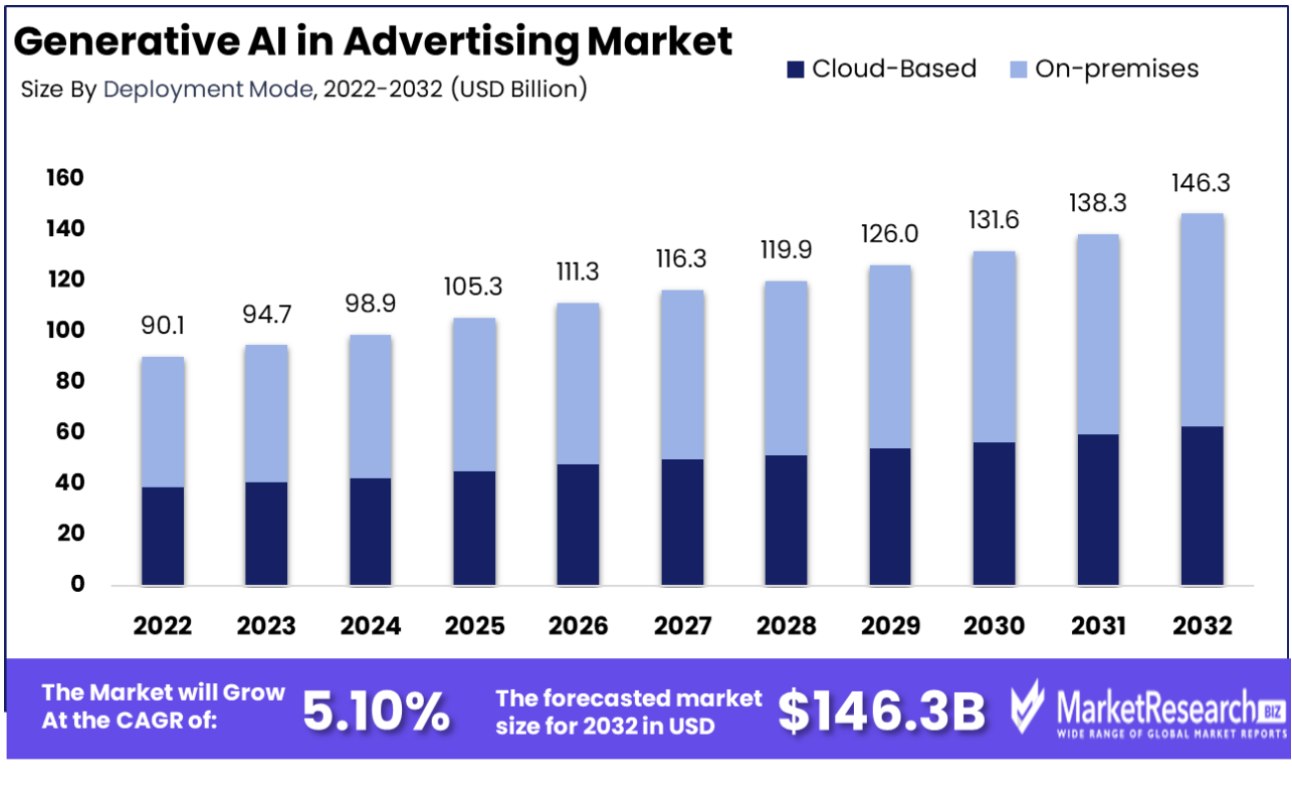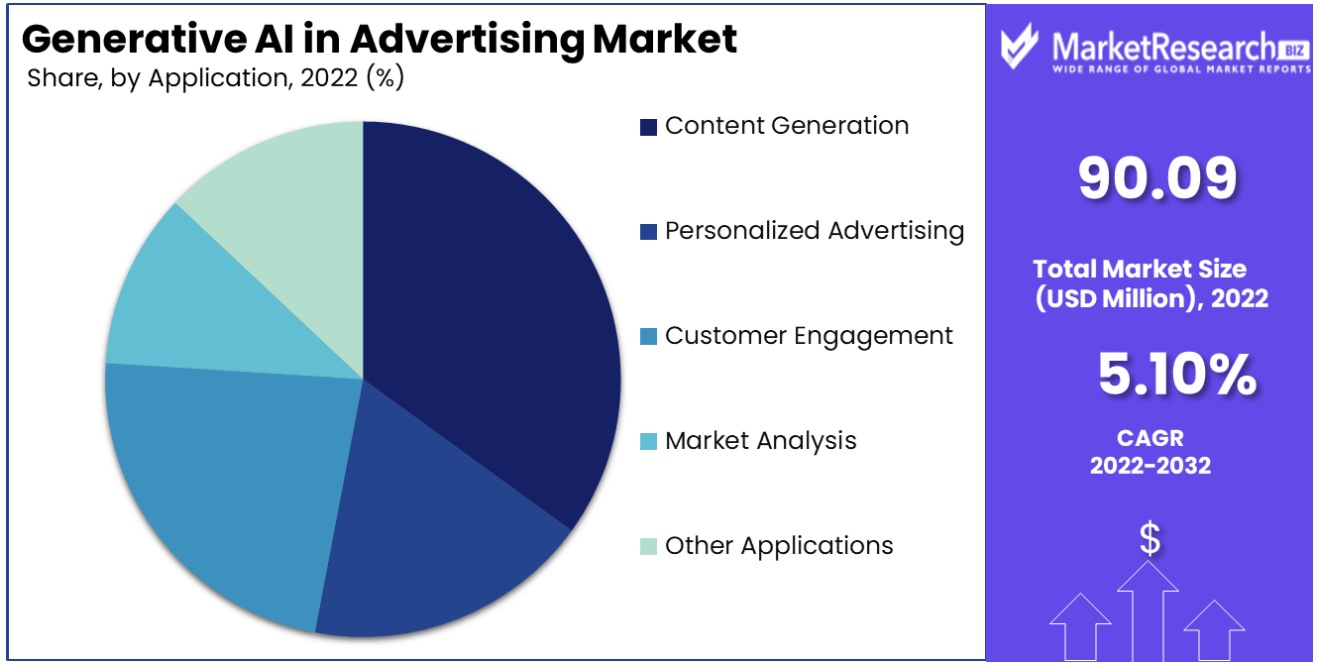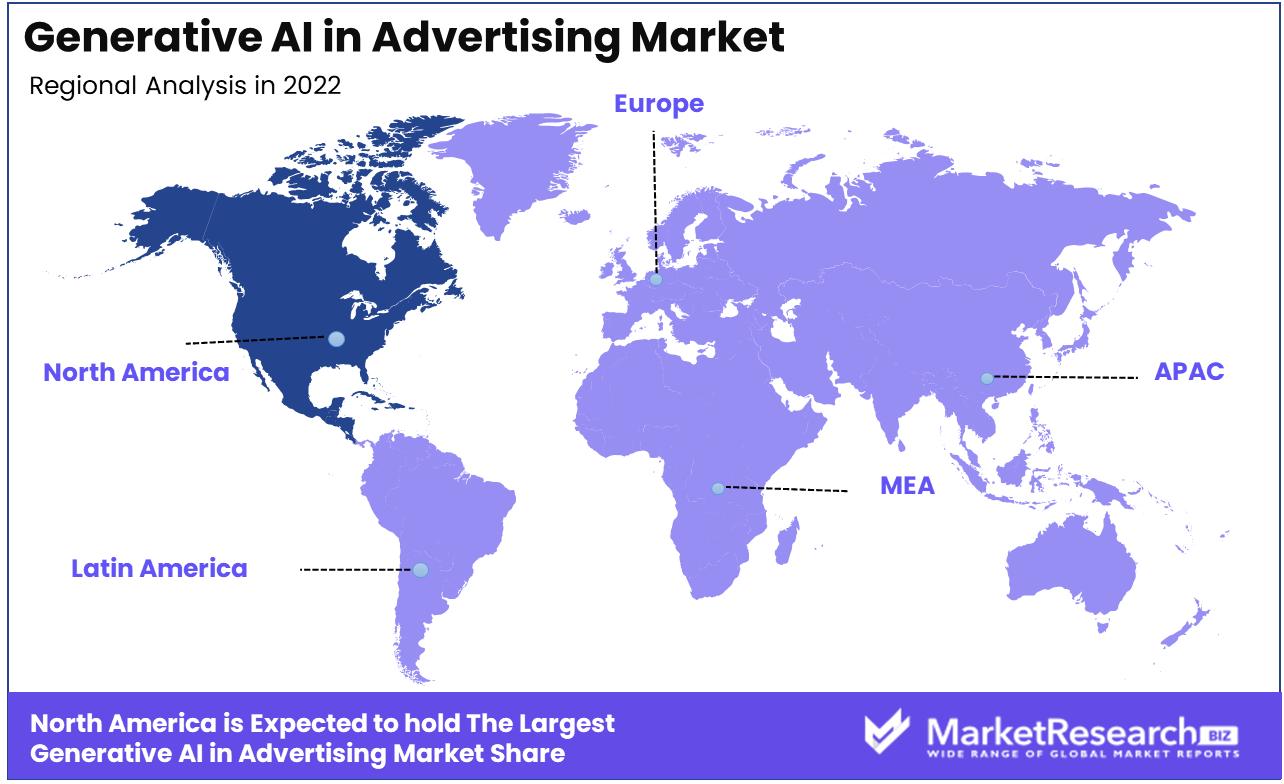
Generative AI in Advertising Market By Deployment Mode(Cloud-Based, On-premises), By Application(Content Generation, Personalized Advertising, Customer Engagement, Market Analysis, Other Applications), By Industry Vertical(Retail, Healthcare, Financial Services, Automotive, Other Industry Verticals) By Region And Companies - Industry Segment Outlook, Market Assessment, Competition Scenario, Trends, And Forecast 2023-2032
-
42500
-
Feb 2022
-
150
-
-
This report was compiled by Vishwa Gaul Vishwa is an experienced market research and consulting professional with over 8 years of expertise in the ICT industry, contributing to over 700 reports across telecommunications, software, hardware, and digital solutions. Correspondence Team Lead- ICT Linkedin | Detailed Market research Methodology Our methodology involves a mix of primary research, including interviews with leading mental health experts, and secondary research from reputable medical journals and databases. View Detailed Methodology Page
-
Quick Navigation
The Generative AI in Advertising Market size is predicted to reach approximately USD 147.9 Bn by 2032, from a valuation of USD 90.09 Bn in 2022, growing at a CAGR of 5.10% during the forecast period from 2023 to 2032.

Generative AI in advertising refers to the application of advanced artificial intelligence technologies that can autonomously generate creative content, such as text, images, and videos, for marketing purposes. Leveraging algorithms like deep learning and natural language processing, this AI can produce unique and personalized advertising materials at scale. It enables marketers to create more targeted and varied content efficiently, enhancing engagement and relevance for different audiences. The key advantage lies in AI's ability to analyze vast amounts of data to identify trends and preferences, thereby optimizing ad content for effectiveness.
With 60% of organizations actively implementing or planning to integrate generative AI into marketing and three-quarters allocating budgets for this, there is a clear trend toward embracing these technologies. Big advertisers like Nestle, Oreo, and Unilever utilizing generative AI software for productivity and cost reduction demonstrate the technology’s growing influence. Collaborations like WPP's with Nestle and Mondelez to implement generative AI in campaigns indicate a significant shift towards AI-driven advertising, promising substantial market growth and cost efficiency.
Moreover, Generative models can craft highly personalized multi-channel campaigns by combining product/brand information with user profiles. This approach significantly enhances reach and relevance, especially for microsegments. However, to ensure appropriate and effective content, these models require well-defined guardrails. The growing ability of generative AI to tailor advertising content to individual preferences and behaviors highlights its potential to revolutionize personalized marketing strategies, opening new avenues for market expansion.
Generative AI's capacity to autonomously create a plethora of advertising assets like images, videos, and copywriting offers substantial cost savings and creative exploration opportunities for agencies and brands. While scalability is a key advantage, there is a concern about losing the human creative touch. In October 2023, Meta expanded the launch of its generative AI elements for ad creation, featuring text variations, background generation, and image expansion tools. According to Meta, advertisers in early testing estimate that generative AI could save them five or more hours per week, allowing for the creation of multiple asset variations with a single click. Such new AI tools also contributed to driving campaign performance by enabling quicker development of ad creative variations at scale.
The exploration of generative AI tools by major online advertising platforms like Meta, Alphabet, and Amazon showcases the anticipated integral role of these technologies. WPP's collaboration with NVIDIA on May 2023, to develop a content engine using NVIDIA Omniverse™ and AI exemplifies cutting-edge applications in creating high-quality commercial content efficiently. This trend indicates a burgeoning market for generative AI in advertising, with major players investing in the technology to maintain competitiveness and enhance creative capabilities at scale.
Driving Factors
Cost Efficiency and Enhanced Testing Transform Advertising
Generative AI's ability to create countless customized ads at a fraction of the cost of human-created content is revolutionizing the advertising industry. This cost efficiency enables advertisers to experiment with a much wider array of creative options without the financial constraints typically associated with traditional content creation.
Generative AI facilitates extensive A/B testing and rapid iterations, allowing for more data-driven decision-making in advertising strategies. The long-term implications are profound, as this could democratize high-quality advertising, making it accessible to smaller businesses while also providing larger companies with the ability to optimize their ad campaigns more effectively.
Accelerated Content Creation Redefines Ad Production
The capacity of generative models to produce high-quality ad images, videos, and copy in seconds is drastically shortening the content creation timeline. Traditional methods, which could take days or weeks, are being outpaced by AI's ability to generate rapid, customized ad assets.
This acceleration allows for more dynamic and responsive advertising campaigns, where content can be quickly developed and deployed in response to real-time market trends or consumer feedback. The impact of this shift will likely continue to grow, fostering a more agile and adaptive advertising landscape.
Multimodal and Contextual AI Elevates Ad Experiences
Generative AI enables the integration of multiple modalities, such as animation, video, audio, and text, into dynamic cross-media ad experiences. These multimodal formats offer interactive and engaging advertising that was previously challenging or impossible to create manually.
Additionally, AI's ability to provide contextual visual augmentation through object recognition and generative models allows ads to be tailored specifically to the target customer and brand context. This personalization and contextualization are transforming how brands connect with consumers, making advertisements more relevant and effective. The long-term implications include a more immersive and personalized consumer experience in advertising, potentially increasing engagement and effectiveness.
Restraining Factors
AI Regulation Uncertainties Slow Generative AI Adoption in Advertising
Rules focusing on transparency, fairness, privacy, and AI ethics are still in development stages in many regions. This emergent state of AI regulation creates legal uncertainties, making companies cautious about adopting these technologies for fear of non-compliance with future laws.
Complex and varying regulations across different markets can make it challenging for businesses to implement generative AI solutions that adhere to all legal standards. This regulatory uncertainty can slow the adoption of generative AI in advertising, as companies navigate this uncertain legal environment.
Computing Power Needs Limit Small Advertisers from Adopting Generative AI
State-of-the-art generative AI models demand substantial computing resources, which can be a barrier for small advertisers. The need for powerful and expensive hardware, such as cloud-based Tensor Processing Units (TPUs) or Graphics Processing Units (GPUs), to train and run these models, represents a significant investment.
For smaller advertising agencies or businesses with limited technical resources, this requirement can be a deterrent. The cost and complexity of accessing and maintaining the necessary computing infrastructure can restrict the use of generative AI to larger companies with more substantial resources, thereby limiting market growth by excluding a large segment of potential small and medium-sized enterprises (SMEs).
Generative AI in Advertising Market Segmentation Analysis
By Deployment Mode
The cloud-based deployment mode for generative AI in advertising has emerged as the dominant segment, currently holding a 61% market share. This dominance can be attributed to the scalability, flexibility, and cost-efficiency that cloud-based solutions offer. Businesses, especially small and medium-sized enterprises, are increasingly adopting cloud-based AI solutions to streamline their advertising efforts without the need for significant upfront investments in IT infrastructure. The cloud-based model enables seamless integration of AI tools with existing digital advertising platforms, facilitating real-time data analysis and decision-making.
The on-premises deployment mode, while less dominant, plays a crucial role in organizations that prioritize data security and control. Large enterprises with sensitive data, particularly in regulated industries, often prefer on-premises solutions despite the higher costs and complexity. This segment ensures the market's diversity and caters to specific needs that cloud-based solutions might not fully address.
By Application
Personalized advertising, holding a 35% share, stands out as the dominant application of generative AI in advertising. This segment's growth is underpinned by the increasing demand for tailored advertising experiences among consumers. Personalized advertising leverages AI to analyze consumer data, such as browsing history, purchase patterns, and preferences, to deliver highly targeted and relevant ads. This approach not only enhances user engagement but also improves ROI for advertisers by increasing conversion rates.
Content Generation is another application that is observing significant growth. It utilizes AI to craft unique, compelling advertising content, aligning closely with consumer preferences and behaviors. Customer Engagement leverages AI to deepen the interaction between brands and consumers, creating a more personalized experience. Market Analysis employs AI to offer valuable insights into evolving market trends and consumer behaviors, guiding strategic advertising decisions.
Generative AI in advertising intertwines content strategy with an intricate understanding of consumer behavior. It delves deep into data-driven insights to decode consumer preferences, trends, and patterns, enabling the crafting of hyper-personalized content strategies. By leveraging this technology, advertisers can adapt their approaches in real time, tailoring content to match evolving consumer behaviors. This synergy fosters the creation of highly targeted, resonant messaging that speaks directly to the audience's interests, aspirations, and needs, fostering stronger connections and driving engagement in the ever-evolving landscape of consumer

By Industry Vertical
In the industry vertical segment, retail stands out with a 30% share, indicating its significant application of generative AI in advertising. The retail sector's adoption of AI-driven advertising strategies is driven by the need to compete in a highly dynamic and customer-centric market. AI in retail advertising focuses on creating personalized shopping experiences, optimizing inventory management through predictive analytics, and enhancing customer service with AI-powered chatbots and virtual assistants.
Healthcare focuses on patient-centric advertising, using AI to tailor awareness campaigns and improve patient engagement. Financial Services employ AI to customize advertising of financial products and enhance customer education, aligning with consumer financial needs and preferences. The Automotive sector uses AI for targeted advertising of vehicles and services, catering to specific consumer demographics and interests. Other industry verticals, including entertainment, education, and travel, are exploring AI for innovative advertising strategies, thereby broadening the scope and effectiveness of AI in various market contexts.
Generative AI in Advertising Market Segments
By Deployment Mode
- Cloud-Based
- On-premises
By Application
- Content Generation
- Personalized Advertising
- Customer Engagement
- Market Analysis
- Other Applications
By Industry Vertical
- Retail
- Healthcare
- Financial Services
- Automotive
- Other Industry Verticals
Generative AI in Advertising Market Regional Analysis
North America Dominates with a 37% Market Share
North America's 37% dominance in the Generative AI Advertising Market is primarily driven by its robust digital infrastructure and high levels of technology adoption. The region is home to many leading AI technology firms and startups, fostering innovation and advancement in generative AI applications. Furthermore, the presence of a mature advertising industry that readily integrates new technologies plays a critical role. This is compounded by substantial investments in AI and machine learning, alongside a strong emphasis on personalized and targeted advertising strategies, which generative AI greatly enhances.

The dynamics of North America's market are influenced by its progressive technological landscape and early adoption trends. Businesses in this region are quick to embrace AI-driven solutions to stay competitive, leading to a dynamic and rapidly evolving market. The openness towards experimenting with new technologies in advertising, combined with a sophisticated consumer base, further fuels the growth and innovation within this sector. Additionally, stringent data privacy regulations in North America prompt the adoption of AI to achieve efficient, compliant advertising strategies.
Europe Is A Close Contender in AI Advertising
Europe's market share in Generative AI for advertising is significant, driven by its advanced technological infrastructure and stringent data privacy laws like GDPR. These regulations push companies to adopt AI for efficient, privacy-compliant advertising strategies. Europe’s diverse market and strong focus on ethical AI applications also influence its market dynamics, fostering innovations that prioritize consumer privacy and ethical standards. Looking forward, Europe is likely to maintain its strong position, with increased adoption of AI in advertising, especially in areas prioritizing data security and ethical AI use.
Asia-Pacific's Rapidly Growing AI Adoption
The Asia-Pacific region's growth is fueled by the increasing digitalization of economies, particularly in countries like China, Japan, and India. The region's vast consumer base and growing internet penetration offer immense opportunities for AI-driven advertising. Market dynamics are characterized by a keen interest in AI innovations, driven by both large corporations and a vibrant startup ecosystem. Prospects suggest a significant increase in market share, with expanding digital infrastructure and growing tech-savvy consumer populations driving demand for AI in advertising.
Generative AI in the Advertising Industry By Region
North America
- The US
- Canada
Europe
- Germany
- France
- The UK
- Spain
- Italy
- Russia
- Netherlands
- Rest of Europe
Asia-Pacific
- China
- Japan
- South Korea
- India
- New Zealand
- Singapore
- Thailand
- Vietnam
- Rest of Asia Pacific
Latin America
- Brazil
- Mexico
- Rest of Latin America
Middle East & Africa
- South Africa
- Saudi Arabia
- UAE
- Rest of the Middle East & Africa
Generative AI in Advertising Market Key Player Analysis
OpenAI, a trailblazer in generative AI, leads with groundbreaking technologies like GPT-3, influencing the market through innovative content generation capabilities. Google and Facebook, with their vast data resources and AI expertise, are pivotal in integrating generative AI into targeted advertising, personalizing customer experiences, and optimizing ad performance.
Adobe and IBM Watson, known for their creative and cognitive solutions, play crucial roles in enhancing creative processes and predictive analytics in advertising. Their tools empower marketers to create more engaging and effective campaigns. Amazon Advertising and Baidu Inc., leveraging their e-commerce and search engine platforms, utilize generative AI to refine ad targeting and improve ROI.
Taboola and Criteo, specializing in ad tech, contribute significantly to the market by using AI to enhance ad relevance and engagement. Their technology demonstrates the industry's shift towards more sophisticated and efficient ad delivery systems. Zeta Global and Salesforce, with their focus on customer data platforms and CRM, underscore the importance of integrating generative AI into broader marketing strategies.
Major Market Players in Generative AI in Advertising Market
- OpenAI
- Meta | Social Metaverse Company
- Adobe
- IBM Watson
- Amazon Advertising
- Baidu Inc.
- Taboola
- Criteo
- Zeta Global
- Salesforce
- Smartly.io
- Phrasee
- Other Key Players
Recent Developments
- On December 2023, the Institute of Practitioners in Advertising (IPA) and the Incorporated Society of British Advertisers (ISBA) jointly introduced twelve guiding principles for the ethical use of generative AI in advertising. The principles aim to ensure responsible AI utilization that protects consumers and the creative sector.
- In October 2023, Amazon has introduced a new generative AI solution in beta called image generation to assist advertisers in creating more engaging ads. The tool is user-friendly, requiring no technical expertise, and is available in the Amazon Ad Console. Advertisers can select a product, click "Generate," and receive a set of lifestyle and brand-themed images based on product details.
- In October 2023, it was reported that Meta Platforms (META) is introducing generative AI tools to all advertisers on its platforms. With almost all of Meta's revenue (98%) dependent on advertising, the move aims to enhance the advertising experience for businesses.
- In September 2023, Typeface, a generative AI app provider and Google Cloud partner, unvieled a new integrated generative AI marketing solution in collaboration with GrowthLoop. This solution incorporates Google Cloud's BigQuery and GenAI Foundation Models to streamline generative AI workflows for marketers. The aim is to facilitate faster campaign launches and ensure a consistent brand message across various touchpoints.
- In May 2023, NVIDIA and global marketing firm WPP have joined forces to create a generative AI-enabled content engine for digital advertising in the APAC region. The collaboration aims to empower creative teams to efficiently produce high-quality commercial content on a large scale. The engine integrates 3D design, manufacturing, and creative supply chain tools, including Adobe and Getty Images, allowing WPP's artists to combine 3D content creation with generative AI.
- First Broadcasted on May 2023, the WWF Deutschland - Bee Radio ad campaign creatively utilized Google's "Hum to Search" tool, allowing wild bees to generate songs from their humming. The unique tracks were broadcasted on Bee Radio, generating income for WWF's wild bee fund through ad revenue.
Report Scope
Report Features Description Market Value (2022) USD 90.09 Billion Forecast Revenue (2032) USD 147.9 Billion CAGR (2023-2032) 5.10% Base Year for Estimation 2022 Historic Period 2016-2022 Forecast Period 2023-2032 Report Coverage Revenue Forecast, Market Dynamics, COVID-19 Impact, Competitive Landscape, Recent Developments Segments Covered By Deployment Mode(Cloud-Based, On-premises), By Application(Content Generation, Personalized Advertising, Customer Engagement, Market Analysis, Other Applications), By Industry Vertical(Retail, Healthcare, Financial Services, Automotive, Other Industry Verticals) Regional Analysis North America - The US, Canada, Europe - Germany, France, The UK, Spain, Italy, Russia, Netherlands, Rest of Europe, Asia-Pacific - China, Japan, South Korea, India, New Zealand, Singapore, Thailand, Vietnam, Rest of Asia Pacific, Latin America - Brazil, Mexico, Rest of Latin America, Middle East & Africa - South Africa, Saudi Arabia, UAE, Rest of Middle East & Africa Competitive Landscape OpenAI, Google, Facebook, Adobe, IBM Watson, Amazon Advertising, Baidu Inc., Taboola, Criteo, Zeta Global, Salesforce, Smartly.io, Phrasee, Other Key Players Customization Scope Customization for segments, region/country-level will be provided. Moreover, additional customization can be done based on the requirements. Purchase Options We have three licenses to opt for Single User License, Multi-User License (Up to 5 Users), Corporate Use License (Unlimited User and Printable PDF) -
-
- OpenAI
- Adobe
- IBM Watson
- Amazon Advertising
- Baidu Inc.
- Taboola
- Criteo
- Zeta Global
- Salesforce
- Smartly.io
- Phrasee
- Other Key Players




